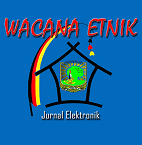LEKSIKON GERAK TARI BUAI-BUAI
Abstract
This study aims to classify the forms of language units of the Buai-Buai Dance lexicon and the lexicon meanings of the names of the Buai-buai Dance movements in Pauh, Padang City. In this study, an anthropolinguistic approach is used to study the intricacies of language whose study is related to culture.
Based on the results of data analysis, 31 linguistic unit lexicon data were obtained in the form of words, phrases, and clauses. The word lexicon found 19 data consisting of 8 complex and 11 single data lexicons. The phrase data contains ten data, which are nine attributive endocentric phrase lexicons and one modified endocentric phrase lexicon data. The clause data has 3 data, namely intransitive clauses.
Keywords
Full Text:
PDF (Indonesian)References
Chaer, A. (2007). Leksikologi dan Leksikografi Indonesia. Jakarta: Rineka Cipta.
Irwandi. (2017). Konsep Pitunggua dan Pola Pengajaran Silat Pauh di Perguruan Silat Singo Barantai Padang (Tesis). Institut Seni Indonesia Padangpanjang.
Kridalaksana, H. (1994). Kelas Kata dalam Bahasa Indonesia. Jakarta: Gramedia Pustaka Utama.
Kridalaksana, H. (2008). Kamus Linguistik. Jakarta: Gramedia.
Sibarani, R. (2004). Antropolinguistik. Medan: Penerbit Poda.
Sudaryanto. (1993). Metode dan Aneka Teknik Analisis Bahasa. Yogyakarta: Gajah Mada University Press.
Tarigan, H. G. (1983). Prinsip Dasar Sintaksis. Bandung: Angkasa.
DOI: http://dx.doi.org/10.25077/we.v10.i2.175
Refbacks
- There are currently no refbacks.
REPOSITORI / TERINDEKS DALAM
STATISTIK PENGUNJUNG














